Moving into the structural elements of light enhances photographic skill. Light quality is infinite and changes all the time, yet once appreciated and acknowledged, its variables are intriguing. Photographers have the unique opportunity to control light and as a result, share stories, original concepts and unique ideas. This is done not only by considering camera controls, lens choice and modifiers but truly being in tune with the environment at hand. If you understand how light will play into your exposure, and further more your own creative voice, you are guaranteed to walk the world from a different perspective.
In its most simple form, light takes shape in three different ways; available or natural light, studio or artificial light and finally a combination of the natural and artificial. The approach is completely straightforward giving you as artist and architect a chance to open up to new theories in light as much or as little as you would like. Let’s take a deeper look and uncover some of the effective forms of light found within these three categories along with helpful tips to develop image style.
Light By Degrees
Early morning makes for some of the most ethereal photographic compositions. This New York cityscape was shot at blue hour, just before the sun was about to rise. Beautiful blue and lavender light occurs at this time. The cool nature of the light contrasts well with the warmly lit building interiors. Atmospheric conditions make the image all the more interesting as light passes through the particles. Experiment with longer shutter speeds and a tripod using a relatively small aperture for greater depth of field. Blue hour lives in a range of lighting within the transitions of day and night. It is calculated by degrees in relationship to the horizon often referred to as part of magic hour. Blue Hour lies within civil twilight, just before golden hour, which finds its place after the sun rises. Applications like Magic Hour and SkySafari, as well as, sites like Golden-Hour will keep you organized with location information for the sun, moon and related viewable phenomena. Great clarity is achieved during blue hour as the sky is increasing in brightness ever so slightly.
Golden hour, as you may guess is soft and warm, great for landscapes and blissful portraits. Now that the sun is rising you can hand hold your camera with a faster shutter speed and open up the aperture for a shallow depth of field. The time in between blue and golden hour provides the camera with an array of different colors that are never quite the same. Observe your surroundings closely, Magic Hour is not only for wide and medium perspectives.
Front & Back Lighting
Later in the morning and early afternoon, some of the most amazing front lighting can be achieved. In the beginning, as most experience, it is a challenge to move through the fine balance in lighting technique as our sun rises in the sky. So as we dive into this topic of illumination we can maneuver our way around to achieve the desired exposure and level of contrast in the image.
Bathing the subject in light that exists behind you, as the photographer, is an excellent way to create a flattering portrait. The light is usually flat and gentle with little to some amount of contrast. Find some shade to address squinty eyes and sharpened shadows, though at times you may decide to use the contrast making a dynamic image. A reflector is a great modifier to fill darker areas naturally. In the image above, the photographer used a shallow depth of field to separate the Indian woman from the background of a vegetable market. The shaded portrait allows her facial features and colored clothing to seem altogether smooth and velvety. Moving your subject into the full sunlight would be the opposite, accentuating facial features and allowing light and shadow to play across the composition allowing for harder edges.
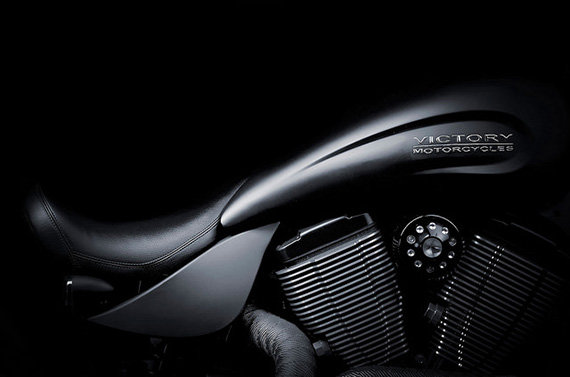
photo by George Shahda
Front lighting can be quite effective in the studio, constructing a recipe of light for your image. Here the light seems to hug the curves of the bike and then falls off into the shadow. A powerful and adjustable Broncolor Para 88 is used to achieve the photograph. The silver interior of the umbrella and parabolic form allows gorgeous light fall-off. Urs Recher and Karl Taylor are two industry voices that demystify the process with their online expertise.
Moving into backlighting, we can begin to see how it will highlight subject matter in a different way. It may create separation from the background and can be used effectively in the studio, indoor environments, as well as outside.
Backlighting is often used to create silhouettes. Travelers at the Singapore Airport now have a dynamic presence waiting by an art installation in this image. Their reflections also appear in silhouette within the polished floor adding depth and dimension to the capture. A moderate shutter speed and aperture were used in this image, along with a faster ISO speed. Light is found in some of the most unusual spaces. The airport is a fascinating place to observe illumination from day to night, inside and out. It is a space of transition in and of itself full of people in flux traveling around the world.
Side Lighting
A particular kind of mood can be reached using light from the side. Contours are easily visible and the shadows make for fascinating depth and dimension. Move around to discover how a simple change in perspective creates interest. Watch the light change as you move up and down, side to side and around the area. Patterns will emerge and disappear depending on the time of day.
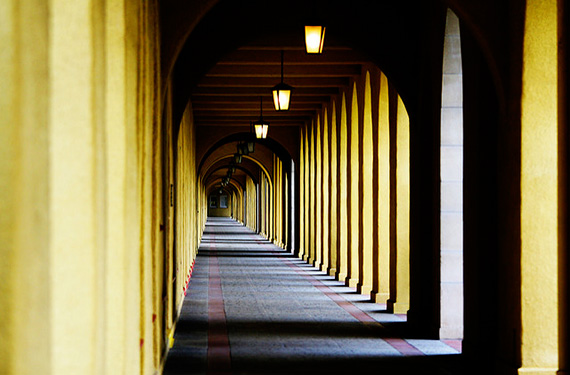
photo by Randy Robertson
Hallways and tunnels are perfect places to see and experience side lighting at work. Long shadows are a result of the light shining through the arches in this image. The light and shadow continues to play on the adjacent wall adding some texture to the yellow facade. Distance within the placement of architectural elements with respect to the time of day will weigh heavily in the intricacy of your image. Visit a site several times and allow your eyes to adjust to striking patterns created by light.
In the studio, exciting works can be developed with side lighting. Rim lighting can be achieved by both back and side lighting. Often it is the combination of the two that produces impressive effects.
This image uses a beauty dish off to the left of the background and behind the dancer, as well as, a small softbox to the right of the background behind the model. Inspiring shots full of movement can be achieved by thinking through the light and its placement. Anything goes!
Hard Light and Fill Flash
There will be times when you want to capture a fast moving subject but also light the details as they speed by. Flash is perfect for this scenario and can be an exciting way to draw your viewer in with an adrenaline filled perspective.
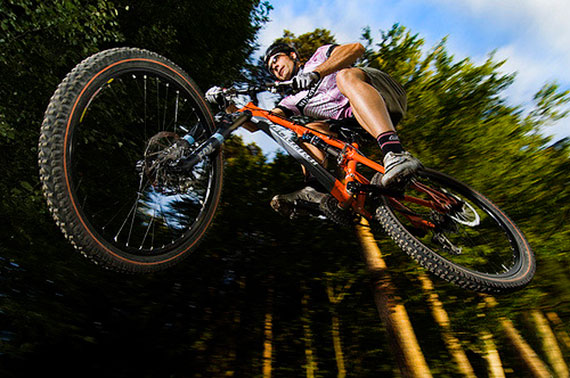
photo by butch gaudy
Here the action is frozen against a slight blur of trees and sky. Our eye is immediately lead up and around the bike to the rider, perhaps sharing in the energetic moment of flying through the woods. Take time to understand your flash and its settings, both automatic and manual. Both will provide different results. This image was taken with the flash in automatic, through the lens metering mode or ttl. The result is a moderate flash sync speed with the shutter to stop the movement. Flash can be used in a variety of different situations and mixes well with available light. The essence is in the power of the flash. Practice using it direct, bouncing it off a wall or ceiling and using diffusers such as the Gary Fong products.
Soft and Diffused Light
Subtle light makes for an even, smooth and all over cast. It is pleasing to the eye and a great space for lifestyle images; close, medium and wide angled. In this image light is coming through a window, diffused by a curtain. Without the fabric harder shadows and more contrast would occur. Instead the photograph is soft and inviting using a moderate shutter speed. The shallow depth of field with its wide open aperture brings our attention to the foreground highlighting texture in this close shot.
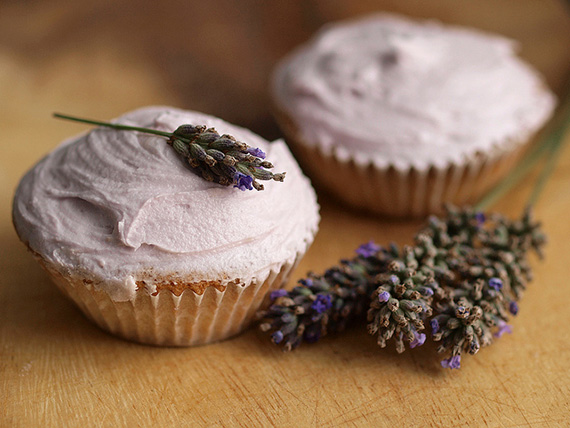
photo by Eric Hossinger
Out in nature with a larger perspective the trees can also diffuse light quite well. Bold color can then be added to call attention like in this image at Golden Ears Provincial Park.
It perfectly contrasts the softness of the environment. In soft and diffused lighting situations indoors and out, a tripod is helpful if you happen to be shooting less than the focal length of the lens. The canopy created by the trees establishes a low lighting situation. Watch for streams of light throughout the day and night both natural and artificial. On the occasion of these moments in transitional light alluring compositions are the result.
Light falling from above can be simply beautiful in lifestyle situations. Move your subject around to see how the light changes. A medium shot will reveal the subtle nature that light provides in the environment and fine delicate texture.
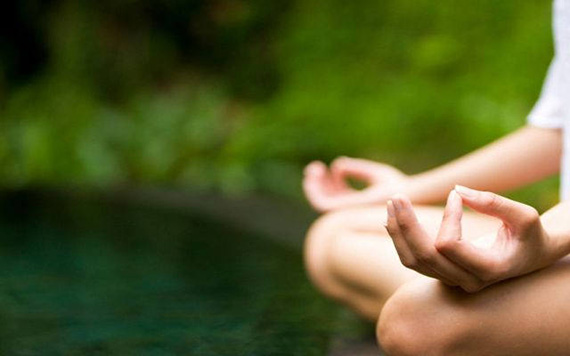
photo by Viaggio Routard
In this image the photographer focuses on the woman’s seated posture in meditation as it has made a space for gathering the light. A wide open aperture is used to blur the background and the subject is placed to the far left of the composition just above a calm body of water. The light captured within the woman’s posture falls off in a way that softly illuminates the pool below.
Combinations of Light
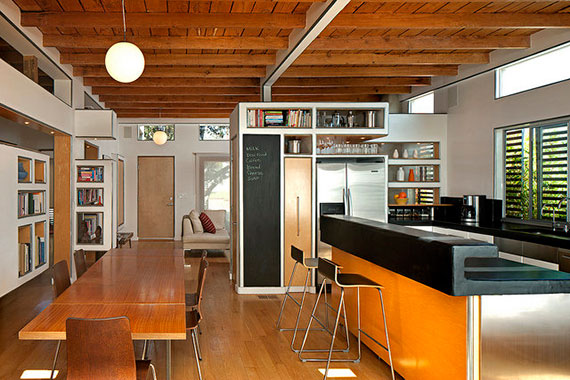
photo by Jeremy Levine
Moving indoors, a world of interior composition awaits. It can bring up challenges in color temperature especially when combining the interior light with the exterior. Technology continues to bring us a wide range of lighting options where only a few existed just a short time ago. Make the best of every situation and try a few different ways to use the light available adding or subtracting as necessary. The result can be quite pleasing. Here, the warmth of the hanging spheres complements the daylight of Los Angeles. A small aperture is used for detail with a slower shutter speed and low ISO. If you happen to mix lighting that looks any less than what you were hoping, some post processing in white balance can be helpful.
A smaller interior without window light will call for a combination of flash and studio lights. There are a number of different ways to light a room with modifiers such as umbrellas, softboxes and secretly placed off camera flashes on tripods. The complexity can be viewed as sculpting with light and allows the task to become creative. Try shooting through a couple umbrellas or bouncing a flash off the ceiling and add additional lights as necessary.
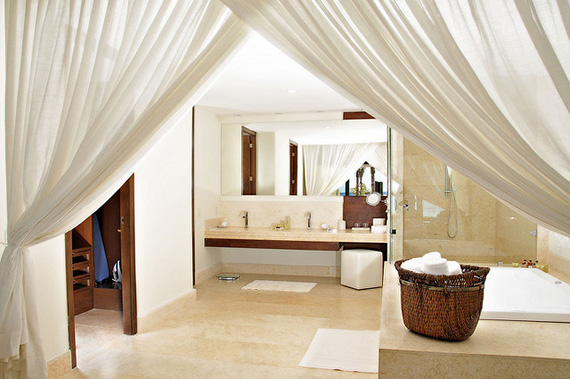
photo by Grand Velas Riviera Maya
After the sun sets experiment with spot lighting in your configuration. Venturing outside to experience the night and early morning before dawn can be rewarding.
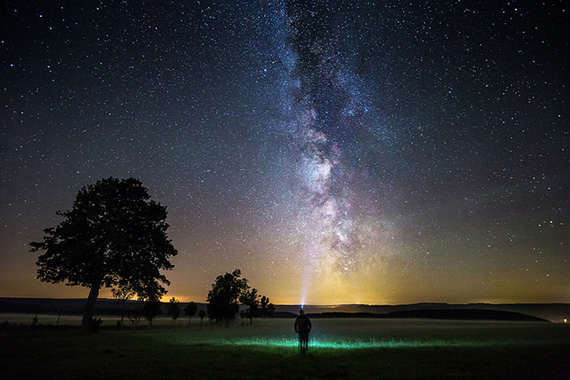
photo by Olli Henze
Here a headlamp is used to add interest to the composition as the subject gazes into the cosmos. A much longer exposure, high ISO and a wide open aperture is used to see the Milky way in the photograph.
Interesting aspects within your scene can be developed with a spot fill in an enclosed area. Take a look at the canyon, it is painted with light during a long exposure. A high ISO is used with a large aperture to expose the night sky.
Seeing beyond what is in front of us has a great impact on our image-making process. Observe light at all times and be inspired to take new steps into how light works. Simply begin by using the existing light of your environment and build upon that, creating solutions as your concepts call for it. It won’t take long before harnessing the most powerful aspect of photography.
About the Author:
Kelly D Hudak is a Miami Beach based photographer.
Like This Article?
Don't Miss The Next One!
Join over 100,000 photographers of all experience levels who receive our free photography tips and articles to stay current:






Hi,
This is Alisa from a photography backdrop company, I really like the articles on your website, they are quite impressive and professional! I want to have a cooperation with you!
I want to know if you provide some cooperation like sponsored post or product review, link insert and please let me know if there is any cost involved. If you’re interested in this, please let me know. :)
Looking forward to your reply! Thank you so much!
This blog is very informative. all the tips are really helpful. keep it up
great helpful article.
Great article, very helpful
This is really great and has helped me a lot as a student!
Very helpful and great pictures
Thanks for information.
LOVE THIS
Great post! Very helpful…
I just kept downloading the images
Its a beautiful post. I like it too much.
They are really very useful article. I like your content. Thanks for sharing nice information.
Very Nice!! Thanks for Sharing..